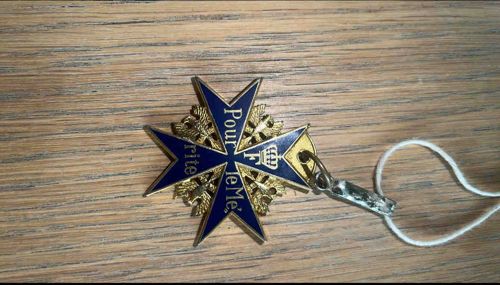
Pour le Mérite (Blue Max) Military Decoration
The item is a small, ornate medal known as the 'Pour le Mérite,' also famously referred to as the 'Blue Max.' It is a cross pattée, characterized by arms that are narrow at the center and expand toward the ends. The arms are primarily a vibrant, dark blue enamel, outlined with a gilded metal edge. The center of the cross on what appears to be the obverse is a gilded circular medallion surrounded by intricate gold filigree, likely laurel or oak leaves, which emerge from behind the blue enameled arms. Inscribed on the blue arms in gilded lettering are the words 'Pour le Mérite', with 'Pour' on the upper arm, 'le' on the right arm, and 'Mérite' on the lower arm. The left arm is blank in this view. On the right arm, below 'le', there is a gilded crown motif. The metal appears to be bronze or gold-plated brass, showcasing a rich, warm tone. The enamel work is largely intact, exhibiting a smooth, glossy finish with no readily apparent chips or cracks. There are minor signs of wear consistent with age and handling, such as slight abrasions or dulling of the gilded surfaces, but no significant damage or repairs are visible. The craftsmanship appears to be of high quality, indicative of detailed production. Attached to the top arm of the cross is a small gilded ring, which then connects to a larger, more robust jumping ring, and finally to a swivel type of clasp or suspension loop made of a silver-toned metal, possibly a period replacement or part of a later attachment. From this clasp, a white string or thread is looped, suggesting it might be either a temporary display string or a remnant of packaging. Given its historical significance and distinctive design, this style period would be late 18th to early 20th century, specifically associated with Prussia and Imperial Germany. The overall condition suggests careful preservation.
AI-Generated Appraisal Disclaimer
Estimated Value
$50,000 - $150,000
Basic Information
Category
Military Decoration
Appraised On
November 28, 2025
Estimated Value
$50,000 - $150,000
Additional Details Provided By Owner
User Provided Information
The missing pour le merite that dissapeared from Germany that is said to be owned by Noah dohme that is the emperor of lixland which is 75 million square kilometers owned by Noah dohme the emperor of lixland which is 18 years it’s his
Item Description
The item is a small, ornate medal known as the 'Pour le Mérite,' also famously referred to as the 'Blue Max.' It is a cross pattée, characterized by arms that are narrow at the center and expand toward the ends. The arms are primarily a vibrant, dark blue enamel, outlined with a gilded metal edge. The center of the cross on what appears to be the obverse is a gilded circular medallion surrounded by intricate gold filigree, likely laurel or oak leaves, which emerge from behind the blue enameled arms. Inscribed on the blue arms in gilded lettering are the words 'Pour le Mérite', with 'Pour' on the upper arm, 'le' on the right arm, and 'Mérite' on the lower arm. The left arm is blank in this view. On the right arm, below 'le', there is a gilded crown motif. The metal appears to be bronze or gold-plated brass, showcasing a rich, warm tone. The enamel work is largely intact, exhibiting a smooth, glossy finish with no readily apparent chips or cracks. There are minor signs of wear consistent with age and handling, such as slight abrasions or dulling of the gilded surfaces, but no significant damage or repairs are visible. The craftsmanship appears to be of high quality, indicative of detailed production. Attached to the top arm of the cross is a small gilded ring, which then connects to a larger, more robust jumping ring, and finally to a swivel type of clasp or suspension loop made of a silver-toned metal, possibly a period replacement or part of a later attachment. From this clasp, a white string or thread is looped, suggesting it might be either a temporary display string or a remnant of packaging. Given its historical significance and distinctive design, this style period would be late 18th to early 20th century, specifically associated with Prussia and Imperial Germany. The overall condition suggests careful preservation.
Get Your Items Appraised
Instant estimates of your treasures with AI-powered instant appraisals